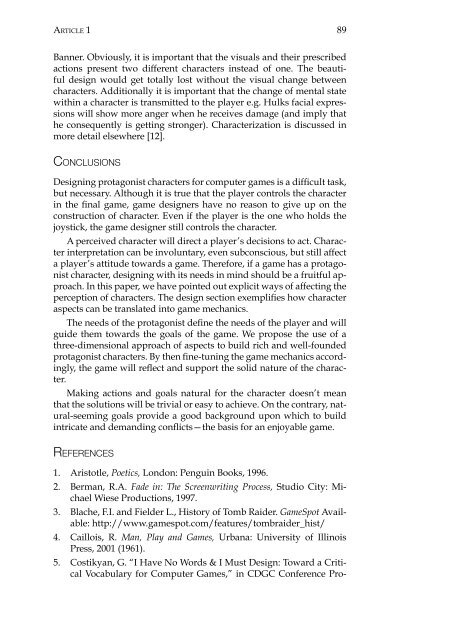Character Driven Game Design
Character Driven Game Design
Character Driven Game Design
You also want an ePaper? Increase the reach of your titles
YUMPU automatically turns print PDFs into web optimized ePapers that Google loves.
Article 1 89<br />
Banner. Obviously, it is important that the visuals and their prescribed<br />
actions present two different characters instead of one. The beautiful<br />
design would get totally lost without the visual change between<br />
characters. Additionally it is important that the change of mental state<br />
within a character is transmitted to the player e.g. Hulks facial expressions<br />
will show more anger when he receives damage (and imply that<br />
he consequently is getting stronger). <strong>Character</strong>ization is discussed in<br />
more detail elsewhere [12].<br />
Conclusions<br />
<strong>Design</strong>ing protagonist characters for computer games is a difficult task,<br />
but necessary. Although it is true that the player controls the character<br />
in the final game, game designers have no reason to give up on the<br />
construction of character. Even if the player is the one who holds the<br />
joystick, the game designer still controls the character.<br />
A perceived character will direct a player’s decisions to act. <strong>Character</strong><br />
interpretation can be involuntary, even subconscious, but still affect<br />
a player’s attitude towards a game. Therefore, if a game has a protagonist<br />
character, designing with its needs in mind should be a fruitful approach.<br />
In this paper, we have pointed out explicit ways of affecting the<br />
perception of characters. The design section exemplifies how character<br />
aspects can be translated into game mechanics.<br />
The needs of the protagonist define the needs of the player and will<br />
guide them towards the goals of the game. We propose the use of a<br />
three-dimensional approach of aspects to build rich and well-founded<br />
protagonist characters. By then fine-tuning the game mechanics accordingly,<br />
the game will reflect and support the solid nature of the character.<br />
Making actions and goals natural for the character doesn’t mean<br />
that the solutions will be trivial or easy to achieve. On the contrary, natural-seeming<br />
goals provide a good background upon which to build<br />
intricate and demanding conflicts—the basis for an enjoyable game.<br />
References<br />
1. Aristotle, Poetics, London: Penguin Books, 1996.<br />
2. Berman, R.A. Fade in: The Screenwriting Process, Studio City: Michael<br />
Wiese Productions, 1997.<br />
3. Blache, F.I. and Fielder L., History of Tomb Raider. <strong>Game</strong>Spot Available:<br />
http://www.gamespot.com/features/tombraider_hist/<br />
4. Caillois, R. Man, Play and <strong>Game</strong>s, Urbana: University of Illinois<br />
Press, 2001 (1961).<br />
5. Costikyan, G. “I Have No Words & I Must <strong>Design</strong>: Toward a Critical<br />
Vocabulary for Computer <strong>Game</strong>s,” in CDGC Conference Pro-
















